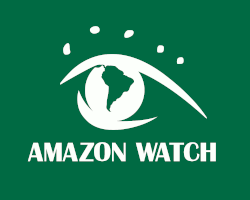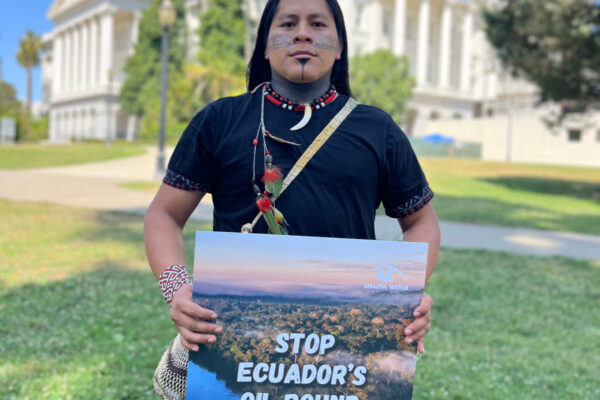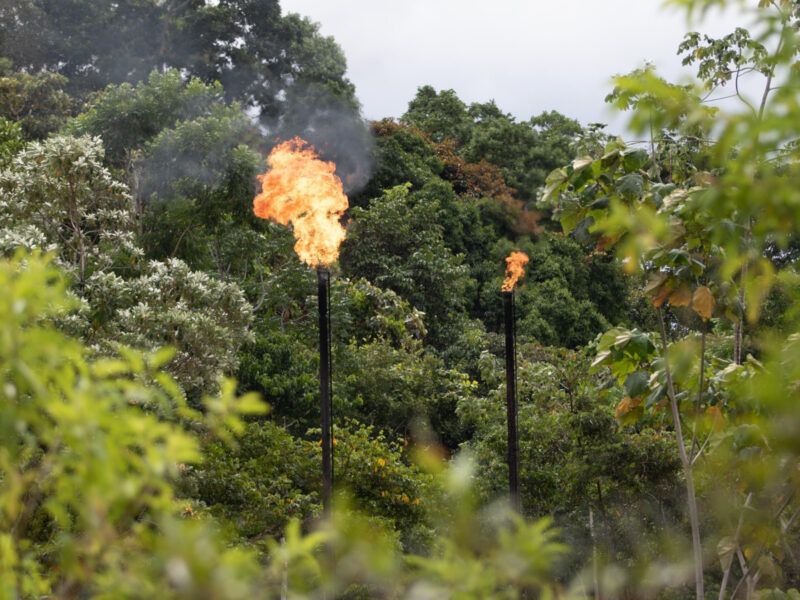Photos and videos of fires and firefighting in Brazil are here.
Quotes from leaders and other resources provided below.
Oakland, CA – The fires raging across the Amazon rainforest are devastating biodiversity–killing millions of animals–Indigenous peoples territories, and further threatening global climate stability. This is an escalating environmental, humanitarian, and climate emergency that requires urgent intervention by the Amazonian governments and the international community. In three Brazilian Amazon states alone, fires have already consumed 5.4 million hectares (54,000 sq. km.), while in Peru fires have reached unprecedented levels, with over 1,800 forest fire alerts recorded. Bolivia has suffered over 17,700 fire points this year – the most ever seen in the first half of any year. In July, there were 11,500 fires recorded in the Brazilian Amazon, followed by 38,000 in August, the highest numbers in 20 years. Last month, the worst-impacted region of the Brazilian Amazon became the largest emitter of CO2 in the world, exacerbating the global climate crisis that is driving historic droughts across the region in a vicious feedback cycle.
Despite a recent decline in Amazon deforestation rates, indicating a positive trend yet still insufficient, severe drought and explosive fires are having devastating consequences on animal and plant biodiversity and the survival of Indigenous peoples and traditional communities who call this critical ecosystem home. Peru’s fires have affected more than 87 Indigenous territories, while in Brazil fires on Indigenous lands spiked by 39% between 2023 and 2024, accounting for 24% of all the Brazilian Amazon blazes this year. More than 1.3 million hectares (13,000 sq. km.) of federally-protected Indigenous territories were reduced to ashes.
In contrast to prior years, where Amazon blazes principally affected degraded forests, many of this year’s fires are also burning in remote areas of primary forest. Natural phenomena such as El Niño have also become more drastic due to climate change. As a result, the Amazon rainforest is weakened and more vulnerable to destructive human activities such as road construction, logging, land grabbing, cattle ranching, mining, and poorly-planned infrastructure development, which leads to greater ecosystem stress, droughts, and fires. Authorities in affected countries have also indicated that criminal arson is partially responsible for this year’s fires.
While today’s environmental and climate crises continue to unfold, the Amazon remains among the most dangerous places in the world for Earth Defenders. Indigenous guardians suffer disproportionate violence and repression, with one in five murders of defenders worldwide occuring in the Amazon in 2022. The Amazon is also increasingly a theater of operations for diverse organized crime syndicates behind a range of environmental and human rights impacts.
Amazon Watch stands with affected Indigenous peoples and traditional communities in calling on the governments of Amazon nations and the international community – particularly those with strong political and economic ties to the region – to take immediate action to address this crisis. These frontline defenders of the Amazon have long demonstrated their deep connection to the land and unparalleled knowledge of its ecosystems. Their leadership is essential for any meaningful and sustainable solution.
In Brazil, the Lula government must fulfill its promises of respecting Indigenous rights and urgently carry out the demarcation of Indigenous lands. This is not only because Indigenous land titling is its constitutional duty, but also because it sends a much-needed signal to destructive actors, from the country’s agribusiness sector to its extractive industries to its criminal networks, that the federal government seeks to prioritize governance and the well-being of the Amazon’s best guardians in an increasingly lawless region.
In Peru, the growing power of industrial and illicit agribusiness such as palm oil, illegal logging, gold mining, and drug trafficking are driving a new wave of deforestation agents, and an explosion in Amazon fires never registered in the country’s history. They must be prevented by repealing anti-forest laws and containing the expansion of illegal economies. And these steps must be concurrent with the recognition and protection of Indigenous land and communities from rising levels of violence.
In Bolivia, the political mandate of the country’s “incendiary laws” which consider forests to be “idle” land awaiting conversion to agro-industrial purposes must be re-evaluated in light of the environmental crisis these policies are provoking. One urgent step would be to ban the expansion of industrial agriculture into new areas and firmly regulate agribusiness and land zoning practices.
The ongoing fires threaten the future of the Amazon rainforest, a cornerstone of Earth’s global weather system, pushing the biome to a disastrous tipping point. The Amazon plays a critical role in regulating the Earth’s climate, and its destruction affects us all. However, it is the rainforest’s Indigenous and traditional communities who are most immediately impacted by today’s emergency, as they are losing their homes, cultural heritage, and ways of life.
We demand that the governments of Amazonian countries:
- Declare this an environmental emergency and provide immediate financial and logistical support for firefighting efforts and recovery in affected areas.
- Establish permanent, well-resourced forest protection programs co-designed and led by Indigenous and traditional communities, including collective land titling initiatives.
- End policies, projects, and financial investments that incentivize deforestation, land grabbing, and harmful industrial expansion in the Amazon.
- Uphold the land rights of Indigenous peoples and bar political attacks on these rights, as their leadership is critical to maintaining the health of the rainforest.
- Establish well-resourced programs that provide effective protection for environmental human rights defenders and community leaders at risk.
- Establish improved national and cross-border security strategies in coordination with Indigenous peoples and local communities to contain the power and influence of organized crime.
We demand that the governments of the international community:
- Provide Amazonian countries with significant funding to finance well-resourced forest protection programs co-designed and led by Indigenous and traditional communities.
- Exercise diplomatic pressure upon Amazonian countries to take urgent and effective action to contain the fires and weaken the ability of their drivers to operate.
- Ensure its financial sector stops investing and financially supporting companies and projects that destroy vital ecosystems, contribute to rising global emissions, and violate human rights, threatening the lives of Indigenous and traditional communities.
Leila Salazar-López, Executive Director of Amazon Watch stated:
“It is truly devastating to once again see fires raging across South America’s most vital ecosystems–the Amazon rainforest, Cerrado tropical savannah, Pantanal wetlands, and the Gran Chaco–threatening communities, biodiversity, and our global climate. This is a climate, environmental, and humanitarian emergency that must be addressed with urgent and immediate action by national and global governments at next week’s UN General Assembly and Climate Week in New York. Failure to act swiftly, brings the Amazon closer to a tipping point, threatening all of our climate future.
In response, as we did in 2019, Amazon Watch has created an Amazon Fire Response Fund to support Indigenous Fire Brigades, respond to emergency humanitarian relief requests from affected Indigenous and traditional communities including their efforts to advance Indigenous land rights and challenge destructive development projects in key areas.”
Julio Cusurichi, Shipibo leader and member of the National Council of AIDESEP in Peru, added:
“Fires in the Peruvian Amazon have even reached Indigenous territories. Now, in addition to dealing with third-party invasions, we also face forest fires, which are on track to further devastate the Amazon. This is why we have been saying for many years that extractive industries are heating up the planet, and directly affecting Amazonian territories, especially the Indigenous peoples who inhabit the Peruvian Amazon. We are calling for logistical support to respond and prevent further fires across the Peruvian Amazon.”
Alessandra Korap Munduruku, Goldman Environmental Prize Winner and coordinator of Munduruku Pariri Association, added:
“Indigenous peoples are demanding the right to have their lands demarcated and if they do not succeed, the planet will not endure. The Amazon’s rivers are drying out at levels we’ve never seen, leaving villages without water, and this is all due to climate change. Why climate change? Because agribusiness wants more land for soy, and cattle and miners want to take our land as well for gold and other minerals. All of this is happening while Brazil’s Congress and Supreme Court work to block Indigenous land demarcation. When you paralyze demarcation, you paralyze life on Earth. Birds die, fish die, rivers dry up, the forest burns–all while soy and cattle expand. Indigenous peoples don’t live from soy; they live from the standing forest, from rivers and their headwaters, from animals, leaves, roots, and fruit. They live from knowledge and from culture. Sadly, with agribusiness halting of demarcation, we are losing all of this knowledge.”
Toya Manchineri, General Coordinator of the Coordination of Indigenous Organizations of the Brazilian Amazon (COIAB) states:
“The fires are a serious problem that harm all of humanity. They are the result of coordinated actions, and, unfortunately, nature may no longer be able to recover. It is everyone’s responsibility to help prevent and monitor them, and the Brazilian State has a duty to support fire brigades as a year-round policy. Currently, the brigades supported by the federal government only receive funds when the fires have already started, but we Indigenous peoples know that managing fires is a year-round task. They are endangering the future of our children. On a planet in flames, no one survives.
Previous Amazon Watch publications on this issue:
- “From Crisis to Catastrophe: The Man-Made Inferno Devouring the Amazon” (2024) – The Amazon’s crippling drought and explosive fires are the result of human-induced climate change, with drastic implications for us all.
- “Deforestation Declines, but Fires Rage On in the Amazon” (2024) – This article delves into the recent dynamic of spontaneous wildfires in remote locations in the Peruvian Amazon rainforest and explains how they are caused by a negative feedback loop made up of increasing climate change effects and deforestation and fragmentation caused by human activity.
- “Brazil’s Burning Season: The Facts About Amazon Fires” (2020) – This report provides a comprehensive look at the ongoing destruction caused by fires in the Amazon, particularly under the Bolsonaro administration. It explains the causes of the fires, the impacts on Indigenous communities, and how agribusiness is fueling the crisis.
- “Flyovers Document Destruction of Brazilian Amazon by Deforestation and Fires” (2021) – This investigative report includes many photos and aerial documentation of the 2021 fires and deforestation in the Amazon, emphasizing the environmental impacts and Bolsonaro’s government’s failure to address the crisis.
- “Forests, Fires, and Finance” (2021) – This report highlights the role of financial institutions like BlackRock and JPMorgan Chase in funding the industries responsible for deforestation and the subsequent fires. It ties together the financial drivers behind the Amazon’s destruction and the global climate crisis.
- “Amazon Fires: Indigenous Peoples Mobilize to Save Their Territories, and the World Steps Up in Solidarity” (2019) – An analysis of the thousands of fires that were deliberately set by Bolsonaro supporters in Brazil during the 2019 fire season, including calls for specific urgent actions to put them out and essential next steps to prevent the crisis from reoccurring every year.
Other articles:
- Amazon Fires Are Soaring Again – but Forest Loss Is Down. What’s Going on? – The Bureau of Investigative Journalism
- Amazon continues to burn, despite decline in deforestation – Le Monde














